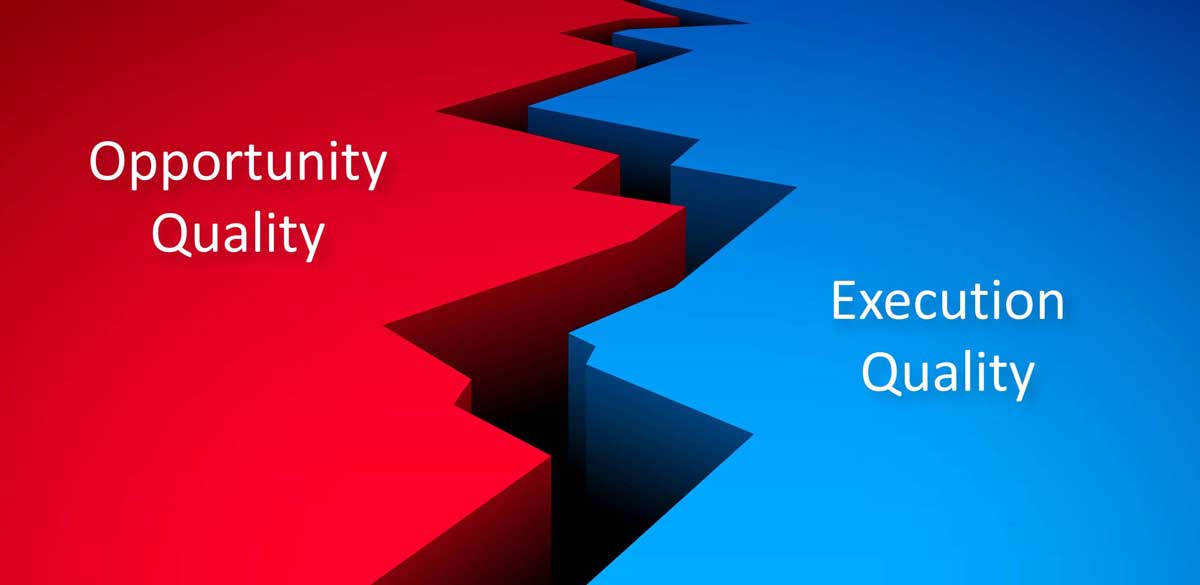Are you launching one breakthrough new product after another? Or are your new products evoking yawns from customers? Research shows the most likely reason for the latter is failing to properly 1) uncover, 2) understand, and 3) prioritize market needs. Here’s how to correct this in your B2B new product development. We shouldn’t be surprised ... Read More
Blog Category: Product Development
Innovation requires attention to both Problem 1 and Problem 2.
Problem 1—What’s the right question?—focuses on market needs. Problem 2—What’s the right answer?—is all about your solutions. Most companies put 90+% of project spending into Problem2, yet Problem 1 causes most new product failures. Hmmm… are you sensing a possible competitive advantage here? Will you explore it further? Will you seize it?
More in white paper, www.catchtheinnovationwave.com (page 4)
Destroy Internal Biases with Voice of the Customer Interviews
Donald Rumsfeld described “unknown unknowns,” but B2B innovators, marketers and new product developers should also consider the dangers of untrue beliefs. It’s quite destructive when we build business cases, draft risk assessments, and plan projects on the basis of something that simply isn’t true. ... Read More
The Amazing ROI for Voice of the Customer
Some would say that investments in Voice of the Customer are “too expensive and time consuming.” After all, does it really make sense for employees to spend time on VoC projects? For them to be on the road, interviewing customers? Instead, shouldn’t they be doing things that “drive sales?” Like working more shows? Assisting sales ... Read More
Why not turn your sales force into a learning force?
Your B2B customers have a long list of problems to be solved. But it’s not their job to carefully explain each one and deliver it gift-wrapped to your solution providers. It’s your job. When your sales professionals probe deeply and capture customer needs uniformly in your CRM, you’ll gain unprecedented market insight. And by probing well, your sales team will sell more. We call this Everyday VOC.
More in Everyday VOC white paper, www.EVOCpaper.com
B2B Organic Growth: Moving to earned growth
A large, unexpected revenue upturn this quarter is good news, right? It certainly feels good, but the satisfaction is fleeting. What you really need is growth that is unrelenting, earned and reliable. When business executives don’t understand the nature of “good” B2B organic growth, they risk three pitfalls. B2B Organic Growth Pitfalls Pitfall 1. “Let’s ... Read More
What is the Value Proposition of a product? The DNA of Successful Innovation
What is the value proposition of a product? The Value Proposition of a product is a formal statement describing the competitive advantage of a new product for a given market segment. Though many examples exist, the jobs-to-be-done methodology provides a precise template upon which to build a clear, concise, unambiguous statement. It tells WHAT we’re ... Read More
Are you prioritizing customer needs?
Most B2B companies don’t have a good system for prioritizing customer needs. At least this is what The AIM Institute found in its recent research. Of 12 voice-of-customer skills measured, this is the skill survey respondents most wanted to improve. Prioritizing customer needs was also identified as the greatest differentiator between successful and unsuccessful new product developers.
More in research report, www.b2bvocskills.com (page 11)
Do your Stage-Gate® reviews separate Execution Quality & Opportunity Quality?
Even if your Stage-Gate® reviews are highly evolved, I’ll bet they’re missing a critical element: I doubt they separate your projects’ Execution Quality and Opportunity Quality. In this issue, we’ll see why this is holding you back. We’ll also look at a brand-new release of Blueprinter® software that remedies this. Imagine you’ve got two project ... Read More
Reduce Bias in Voice of the Customer: Let’s Give your Hypothesis the “Silent Treatment”
The “old way” of interviewing was to “validate” your idea with customers… but this leads to confirmation bias. With the “new way,” you focus on their needs and gain 5 benefits… 1) add new outcomes to your design, 2) eliminate costs for unimportant outcomes, 3) learn why they want outcomes (for better pricing), 4) engage them more, and 5) move faster. ... Read More
Close the Customer Feedback Loop
Quality guru Edwards Deming taught us that “94% of problems in business are systems driven and only 6% are people driven.” With the right systems, a company will grow and thrive. And few are more important than the “feedback loop.” Unfortunately, this term has been used so broadly that the original and powerful meaning has ... Read More
Idea Generation: 12 Rules to Ensure High-Impact Ideas
What is idea generation? Idea generation is the process of generating and selecting ideas to solve discrete problems. However, within the context of new product development, the goal of idea generation is to solve customer problems. After all, every new product begins as an idea. Therefore, if there’s an innovation job that we’d better do ... Read More
Innovation is the last frontier left for us to settle.
The average company only has a 25% success rate after it finishes its front-end work. With Six Sigma success, you’ve got three defects per million attempts… while your new product development is stuck at three defects per four attempts. Can you think of any other area in your company with this level of waste? Don’t let your competitors tame this frontier first.
More in white paper, www.catchtheinnovationwave.com (page 3)
The Front End of Innovation: How much is “too much”?
Our research asked B2B professionals what drives profitable, sustainable organic growth. The #1 answer was delivering strong, differentiated value propositions. And the #1 differentiator between the best and worst value-creating companies was superior front end of innovation work (www.whatdrivesb2borganicgrowth.com). The Front End of Innovation – Key Steps There are important front-end steps top-performing companies take to strengthen their value ... Read More













